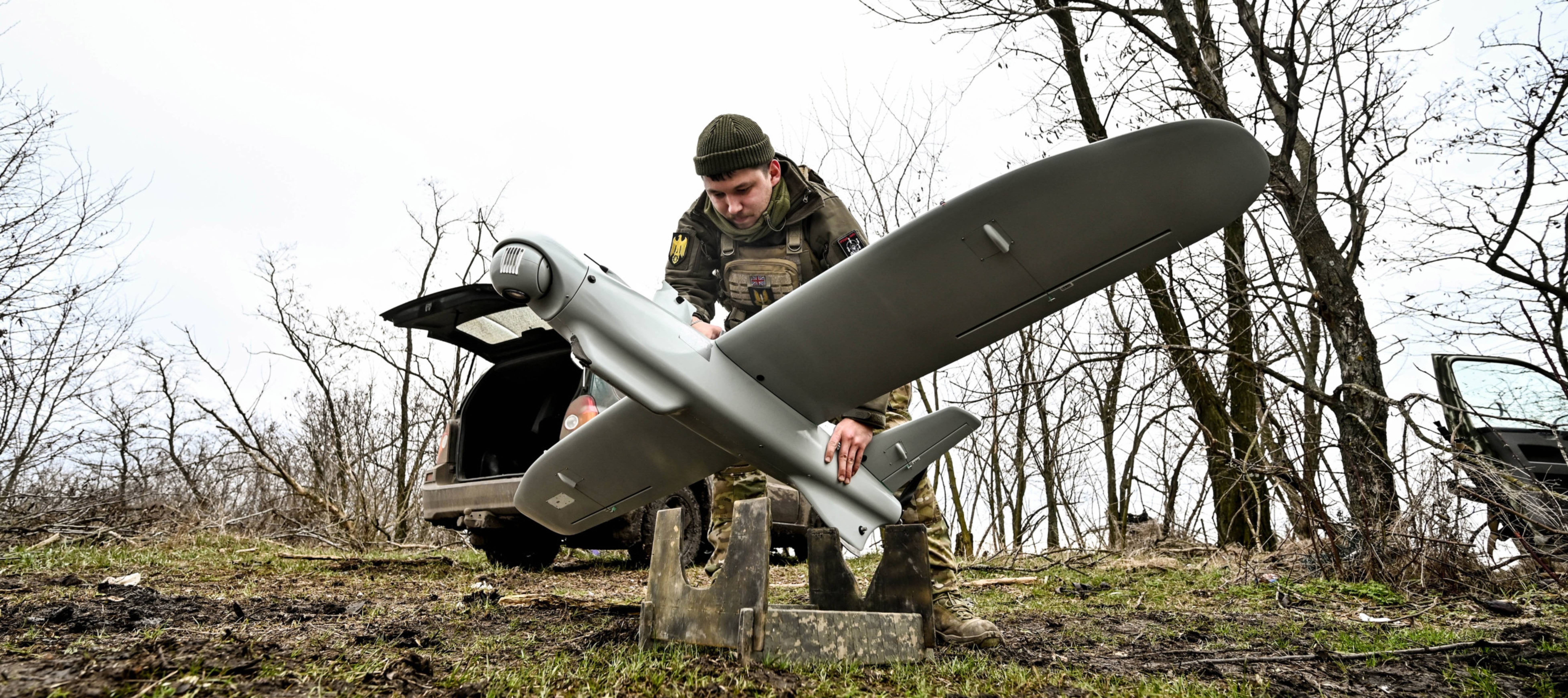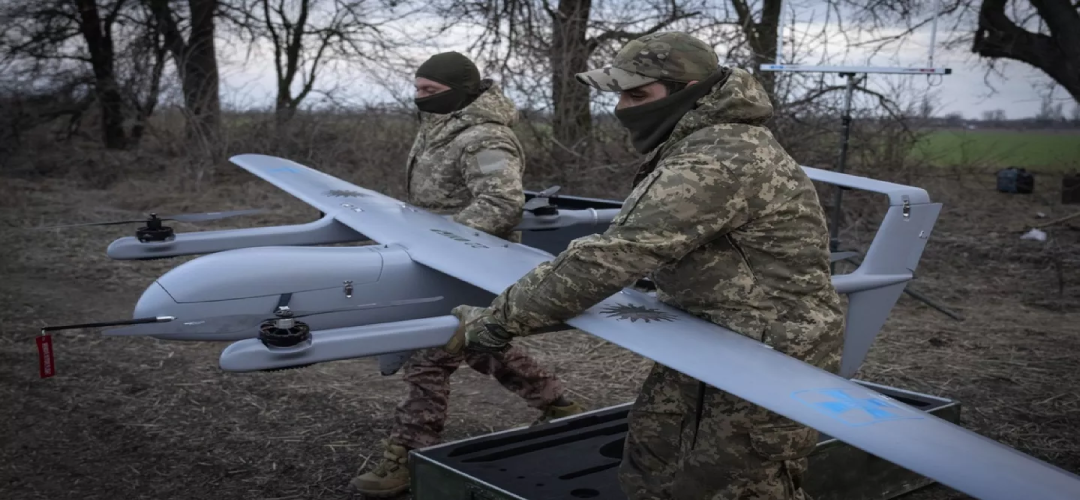Pitted against the Russian Goliath, Ukraine’s proverbial slingshot has been the drone.
Ukraine war is a clear example of how superior use of technology can tilt the balance in favour of the underdog. Ukraine’s war of resistance against Russian occupation has pivoted on its successful use of drones. Ukraine has rapidly increased drone production as demand grows on the frontline.
Every day, drone units from both armies publish videos on social media demonstrating how drones as inexpensive as $500 can effectively destroy costly artillery pieces or tanks worth millions of dollars and showcasing their transformative role in modern warfare.
However, its drones face challenges as Russia responds with its own bouquet of countermeasures, thus triggering a relentless tech war with a new gambit being introduced every day.
Background
With a growing home-grown market for assembling cheap, reusable drones bought off the shelf, Ukraine has eased import laws and removed taxes for drone parts and equipment. A fundraising campaign called the Army of Drones has successfully supported the expansion of drone production.
The Army of Drones is a combined effort of the military, government, and private groups. It has produced a substantial drone force as the government strives to keep up with the technology war. Funds from the campaign are used to create drones and train scores of drone pilots.
With government support, private groups trained 10,000 drone pilots in a year and are looking to scale drone production since drones are crucial to Ukraine’s combat advantage. While Ukraine has received cutting-edge military drones from the U.S. and Turkey, it largely relies on popular Chinese civilian drones that can be bought on the internet for $2,000 or less.
Drones are mainly used for surveillance, giving Ukraine a lead on the battlefield. But they can also carry a small explosive in an attached claw. This can be used to target a single Russian trench, with a cowering Russian conscript inside (who could be an Indian/ a Nepali or some other non-Russian shanghaied into service) or even a tank. Drones help spot the occupying forces so that artillery can be adjusted to neutralise the enemy. Both sides are increasingly relying on smaller, cheaper drones to capture footage. Exploding or Kamikaze drones also play an important role since they compel Russians to withdraw heavy weapons by around 15 kilometres to stay out of range.
Quickly adapting itself to the battlefield realities, Russia, too, has come up with its own drone combatants. Prominent amongst these are Iranian Shaheeds.

Analysis
The sheer imbalance of forces makes it imperative for the smaller military power, Ukraine, to seek disruptive technology to stymie the offensive capacity of the larger power. Unable to match Russian air superiority, fighter to fighter, with the odds as high as 1:10, the Ukrainians have resorted to an effective ground-based air defence, making Ukrainian air space deadly for Russian combat jets. So many Russian aircraft have been shot down that the Russian Air Force is mostly relying on standoff attacks from within its airspace. Even the promised supply of F-16s to the Ukrainian Airforce will likely be committed to air defence.
The lack of airpower makes it imperative for Ukraine to seek alternate platforms for its ISR (Intelligence, Surveillance and Reconnaissance) missions over Russian-held battlefields. Drones are useful for carrying out risky reconnaissance work behind enemy lines, helping preserve the lives of their soldiers. They can map the battlefield in real time and pinpoint tanks and ships to their handlers through a real-time video link. Drones help infantry gain situational awareness. A platoon commander can use even a few small commercial drones to analyse the situation from the starting position. This gives the infantry time to prepare and the commander time to make decisions and helps foil an assault.
If, in the process of aerial reconnaissance, these cheap and easily replaced drones can cause some damage to the Russians, so much the better. YouTube is swamped with videos of such drone attacks on Russian tanks, missile sites, artillery guns and, at times, even individual soldiers; it is Terminator being played out in real life with real human beings being hunted and killed by machines!
Drones also fill in for a shortage of long-range artillery, especially the expensive ammunition for larger calibres like 155 mm. After more than 2 ½ years of combat, both sides have exhausted their supply of munitions and are desperately mining the ammunition stocks globally. Reportedly, Pakistan has been providing Ukraine with 155 mm shells while North Korea has replenished Russian artillery stocks. However, artillery ammunition is expensive, single-use, and mostly unguided (although smart artillery ammunition exists, it is exorbitantly costly). Here again, drones provide an affordable alternate method to carry out deep strikes behind the front lines more accurately than conventional artillery salvos.
It is a strategy of a balanced approach towards maintaining its arsenal that has enabled Ukraine to keep the war going for so long. On the one hand, Ukraine is looking to bolster its firepower through 60-ton Western tanks, U.S. High Mobility Artillery Rocket System (HIMARS), portable air defence and anti-tank missiles from the U.S. and other Western powers and now F-16s. On the other hand, it is making the most of small drones.
Drones are rapidly transcending generations; in the early stages of the war, Ukraine relied on larger drones that loitered and helped strike heavy targets. However, Russia’s air defence and electronic warfare capacities progressed to shoot down these larger drones more easily. Smaller drones, which are harder to detect and shoot down and are easily available off the shelf, have proved useful for Ukraine. Crowd-funding efforts like the Army of Drones have helped amass these drones.
It is costly to intercept cheap drones with air defence systems and artillery. Shooting down one drone could cost thousands of dollars; a single S-300 anti-aircraft-guided missile costs around US$2 million! The total cost of the drone’s components, including an explosive warhead secured with cable ties, can be as little as $500 or less. For this reason, both sides have turned to electronic warfare as a key countermeasure. Jammers send out electromagnetic signals that can cause a drone to fall, go off course, or even attack its operator. Both sides continue to invest in electronic warfare tactics to counter the other side’s innovations. Each side rapidly catches up as the other gains an edge.
A flourishing market for anti-drone technology is getting a much-needed push thanks to the war in Ukraine. The Russians are retaliating with electronic jamming that interrupts the signal between the drone pilot and his drone. Ukraine is working on software that could prevent electronic jamming. For instance, as Ukraine increasingly relied on short-range exploding drones on the frontline, Russians deployed handheld jamming devices. This pushed Ukrainian troops to devise countermeasures to evade Russian jamming devices. Yet, it is likely that Russians will again adapt.
Assessment
- Both sides will continue to focus on expanding drone production as demand from the frontline still exceeds the manufacturing capacity.
- Each side continues to innovate and refine their drones and electronic warfare capabilities in response to the other side as they jostle to gain a combat advantage through a technological upper hand.
- The worst is yet to come; autonomous drones are already in the market and are no longer vulnerable to the tenuous command link to the operator. These fire-and-forget drones will make life that much more difficult for the soldier on the receiving end.




